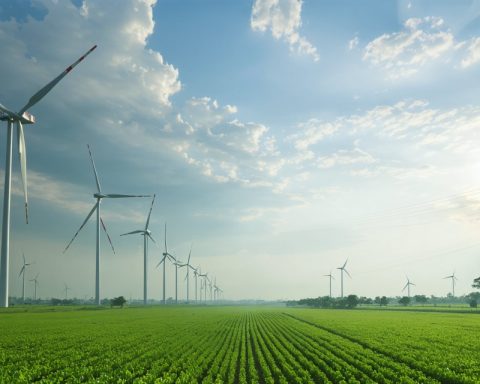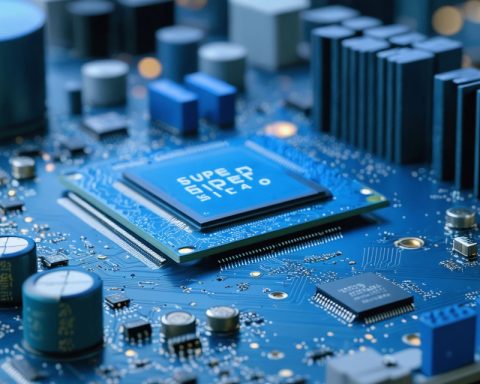- NTPC is investing over $23 billion to advance renewable energy in Madhya Pradesh, with plans for 20GW of clean power.
- Projects include solar panels, wind turbines, and pumped hydroelectric systems, reflecting India’s commitment to carbon neutrality.
- Adani Group will invest INR 2.1 trillion in the region, focusing on energy, infrastructure, smart cities, and coal gasification.
- NTPC aims to triple its nuclear power capacity by 2044, further enhancing its role in sustainable development.
- These initiatives emphasize a shift from fossil fuels to renewable energy as India leads in sustainable practices.
- The future of energy in India is moving towards cleaner, more affordable options, benefiting millions across the nation.
In a monumental move towards sustainable energy, India’s National Thermal Power Corporation (NTPC) is poised to reshape the power dynamics of Madhya Pradesh. The state-owned titan has announced a bold pledge to funnel over $23 billion into renewable energy initiatives. With visionary aspirations, NTPC and its green subsidiary are orchestrating an expansive symphony of solar panels, whirling wind turbines, and innovative pumped hydroelectric systems, all converging to create a formidable 20GW of clean power.
Vibrant winds will soon dance across new wind farms, while sunlight gets trapped and transformed on sprawling solar fields, collectively forming a testament to India’s relentless push towards carbon neutrality. The plans are not just figures on paper; they are a tangible shift from coal and other fossil fuels toward a brighter, cleaner future.
Parallelly, the industrial goliath Adani Group is set to infuse another INR2.1 trillion, which promises to rewrite Madhya Pradesh’s energy and infrastructure landscape. Beyond power, smart cities sparkle on the horizon, weaving technology with everyday life, while innovative coal gasification projects stand ready to redefine resource usage.
As these robust blueprints unfold, NTPC’s ambitions scale even higher, hinting at an audacious tripling of its nuclear power capabilities by 2044. With such projects, India is not only aspiring to lead in sustainable practices but is also spelling out a powerful message: the future of energy is not on the horizon—it’s here, and it’s renewable. This strategic transformation sets a stage where clean, affordable power is not just a vision but an imminent reality for millions.
The Renewable Revolution: How India’s NTPC is Leading the Charge Towards a Greener Future
How-To Steps & Life Hacks: Transitioning to Renewable Energy
Transitioning to renewable energy involves several strategic steps:
1. Assessment: Evaluate current energy consumption and identify areas for improvement.
2. Investment: Secure funding and investments for renewable energy projects. NTPC’s $23 billion investment is a prime example.
3. Technology Selection: Choose appropriate technologies such as solar, wind, or hydroelectric systems based on geographical and climatic conditions.
4. Regulatory Compliance: Ensure all projects meet national and international environmental standards.
5. Infrastructure Development: Build necessary infrastructure like solar panels or wind farms.
6. Community Engagement: Educate and involve local populations to gain support and maximize benefits.
7. Monitoring and Maintenance: Implement systems for regular performance monitoring and maintenance.
Real-World Use Cases
– Solar Farms in Deserts: Vast solar arrays can be efficiently deployed in arid regions, capitalizing on abundant sunlight.
– Offshore Wind Farms: Coastal areas can benefit from wind farms that harness steady sea breezes.
– Pumped Hydroelectric Storage: Utilizing existing reservoirs to create energy storage solutions.
Market Forecasts & Industry Trends
The renewable energy sector in India is projected to grow exponentially. Key trends include:
– Expanding Capacity: India aims to reach 450GW of renewable energy capacity by 2030.
– Falling Costs: Solar and wind technologies are becoming more affordable due to technological advancements.
– Corporate Responsibility: Major corporations increasingly incorporate sustainability into their business models.
Reviews & Comparisons
– NTPC vs. Adani Group: NTPC is focusing heavily on solar and wind, while Adani integrates smart city development and coal gasification, providing a broader infrastructural vision.
– Nuclear Expansion: NTPC’s nuclear energy expansion is notable, but faces challenges related to safety and waste disposal.
Controversies & Limitations
– Land Use: Large-scale solar and wind installations can lead to conflicts over land rights.
– Intermittency: Renewable energy sources can be inconsistent; battery storage solutions are crucial.
– Environmental Impact: Potential impacts on local wildlife, particularly from wind farms.
Features, Specs & Pricing
– Solar: Costs have dropped by approximately 80% in the last decade.
– Wind: Average installation costs range between INR 60-90 million per MW.
– Hydroelectric: Offers dependable energy but involves significant initial capital.
Security & Sustainability
– Energy Independence: Reducing reliance on imported fossil fuels.
– Resilience: Renewable infrastructure can be more resilient to climate change impacts.
Insights & Predictions
– Job Creation: Renewable energy projects are expected to create millions of jobs across construction, maintenance, and technology sectors.
– International Leadership: India’s efforts position it as a leader in global climate action.
Tutorials & Compatibility
– Integration: Renewable systems can often integrate with existing grid infrastructure, but require modernization for optimal efficiency.
Pros & Cons Overview
Pros:
– Reduces carbon footprint and pollution.
– Long-term economic benefits through energy independence.
Cons:
– High initial investment and infrastructure complexity.
– Land and resource allocation issues.
Actionable Recommendations
1. Support Policy Initiatives: Encourage policies that support renewable energy projects.
2. Educate & Engage: Promote awareness of the benefits of renewable energy.
3. Innovate: Invest in emerging technologies like battery storage and smart grids.
For further readings and insights into the renewable energy sector in India, visit NTPC and Adani Group. These organizations are at the forefront of India’s shift towards sustainable energy, leading impactful projects that could redefine the global energy landscape.









